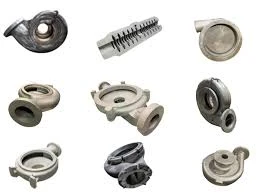Mobile:+86-311-808-126-83
Email:info@ydcastings.com
types of metal casting processes
Understanding Types of Metal Casting Processes
Metal casting is a manufacturing process that involves pouring molten metal into a mold to create a desired shape. This process has been utilized for thousands of years, dating back to ancient civilizations. Today, various types of metal casting processes are employed in different industries due to their versatility, cost-effectiveness, and ability to produce complex geometries. In this article, we will explore some of the most common types of metal casting processes and their applications.
1. Sand Casting
Sand casting is one of the oldest and most widely used metal casting methods. In this process, a mixture of sand, clay, and water is packed into a mold box to create a mold cavity. The molten metal is then poured into the cavity, and once it solidifies, the sand mold is broken away to reveal the cast part. This process is highly versatile and can accommodate a wide range of metals, including aluminum, iron, and steel.
Sand casting is particularly advantageous for producing large and complex parts. It is also relatively low-cost, making it suitable for both small-scale and large-scale production. However, it may not achieve the same level of surface finish or dimensional accuracy as other casting methods.
2. Investment Casting
Investment casting, also known as lost-wax casting, is a more precise method for producing intricate shapes. In this process, a wax pattern of the desired part is coated with a ceramic material to create a mold. Once the ceramic has hardened, the mold is heated to melt away the wax, leaving a hollow mold for the metal to be poured into.
This method is ideal for manufacturing components that require high dimensional accuracy and a smooth surface finish. Investment casting is commonly used in the aerospace, automotive, and medical industries for producing parts like turbine blades, valves, and surgical instruments.
3. Die Casting
Die casting involves forcing molten metal into a steel mold under high pressure. This process is generally used for producing small to medium-sized parts with high volumes. The precision and repeatability offered by die casting make it an excellent choice for manufacturing parts that require tight tolerances.
types of metal casting processes

Die casting can be performed in two main ways hot chamber and cold chamber. Hot chamber die casting is used primarily for metals with low melting points, like zinc, while cold chamber die casting is utilized for metals with higher melting points, such as aluminum and magnesium. This casting method is commonly used in the automotive and consumer goods industries for producing parts such as housings, brackets, and automotive components.
4. Shell Casting
Shell casting is similar to investment casting but uses a sand-resin mixture instead of wax. In this process, a thin shell of sand is formed by heating a mold and applying the sand mixture. Once the shell has cured, it is filled with molten metal. Shell casting is advantageous for its ability to produce complex shapes with good surface finishes and dimensional accuracy.
Typically used for medium-sized components, shell casting is often employed in industries such as defense, aerospace, and oil and gas, to create parts like valve bodies and pump housings.
5. Centrifugal Casting
Centrifugal casting uses centrifugal force to produce cylindrical parts. In this method, molten metal is poured into a rotating mold, allowing the metal to be distributed evenly along the mold's inner surface. This technique is particularly effective for creating pipes, tubes, and hollow cylinders.
Centrifugal casting is renowned for its ability to create parts with excellent mechanical properties and minimal defects. As a result, it is frequently used in industries such as power generation, automotive, and manufacturing machinery.
Conclusion
Metal casting encompasses a diverse range of processes, each with its unique advantages and applications. From sand casting’s versatility to investment casting’s precision, manufacturers have various options to choose from based on their specific needs. Understanding these different types of casting processes can help industries select the best method for producing high-quality parts while optimizing cost and efficiency. As technology continues to advance, we can anticipate further innovations in metal casting techniques that will enhance productivity and expand the possibilities for manufacturing.
-
Why Should You Invest in Superior Pump Castings for Your Equipment?NewsJun.09,2025
-
Unlock Performance Potential with Stainless Impellers and Aluminum End CapsNewsJun.09,2025
-
Revolutionize Your Machinery with Superior Cast Iron and Aluminum ComponentsNewsJun.09,2025
-
Revolutionize Fluid Dynamics with Premium Pump ComponentsNewsJun.09,2025
-
Optimizing Industrial Systems with Essential Valve ComponentsNewsJun.09,2025
-
Elevate Grid Efficiency with High-Precision Power CastingsNewsJun.09,2025











